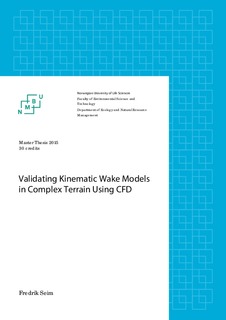| dc.description.abstract | Due to spatial and economic constraints and the limited number of suitable sites, wind
turbines are clustered in wind farms. A turbine operating downwind of another turbine will stand in the wake of the first turbine, encountering reduced wind speeds, higher turbulence and will most likely generate less energy. In order to keep wake losses at a minimum, wind farm designers rely on wake models to optimize the turbine layout. Kinematic wake models are often preferred due to their low calculation time. Measurements from Nygårdsfjellet wind farm located in northern Norway have been used in an attempt to validate three kinematic wake models, namely the Jensen-, Larsen- and Ishihara model. Assisted by the commercial WindSim software, which is based on computational fluid dynamics (CFD), the accuracy of the three models were tested in eight single-wake cases with regard to several key aspects. Due to the complex terrain, a range of issues complicated the validation procedure. The Ishihara model was found to overestimate the normalized power deficit in all cases. The Jensen model also overestimated the peak power deficit, but not to the same extent. Finally, the Larsen model correlated well with the measured data. At the wake centerline, the Larsen model was by far the most accurate, with a mean absolute error of 7 %. The Jensen- and Ishihara model had a mean absolute error of 21 and 34 % respectively. The Larsen model widely overestimated the wake width in all cases, but with an almost constant offset. Both the Jensen- and Ishihara model agreed well with the observed wake width. For the energy loss in the wake, the Larsen model performed best for the three investigated wake cases with a mean absolute error of 29 %, although all the three wake models showed a varying performance with a tendency to underestimate the energy loss. However, after employing a procedure to correct for simulation errors, the Ishihara model performed best with a mean absolute error for 10 %. The actuator disc approach accurately simulated the velocity deficit in the wake, all though a slight overestimation of the wind velocity was present. Overall, findings indicated that the Larsen model performed best, although it constantly overestimated the wake width and showed tendencies to underestimate the energy loss in the wake. But no clear-cut conclusion can be drawn on which model is the most accurate due to both unsatisfactory simulations and high uncertainty in the measurements. | nb_NO |
